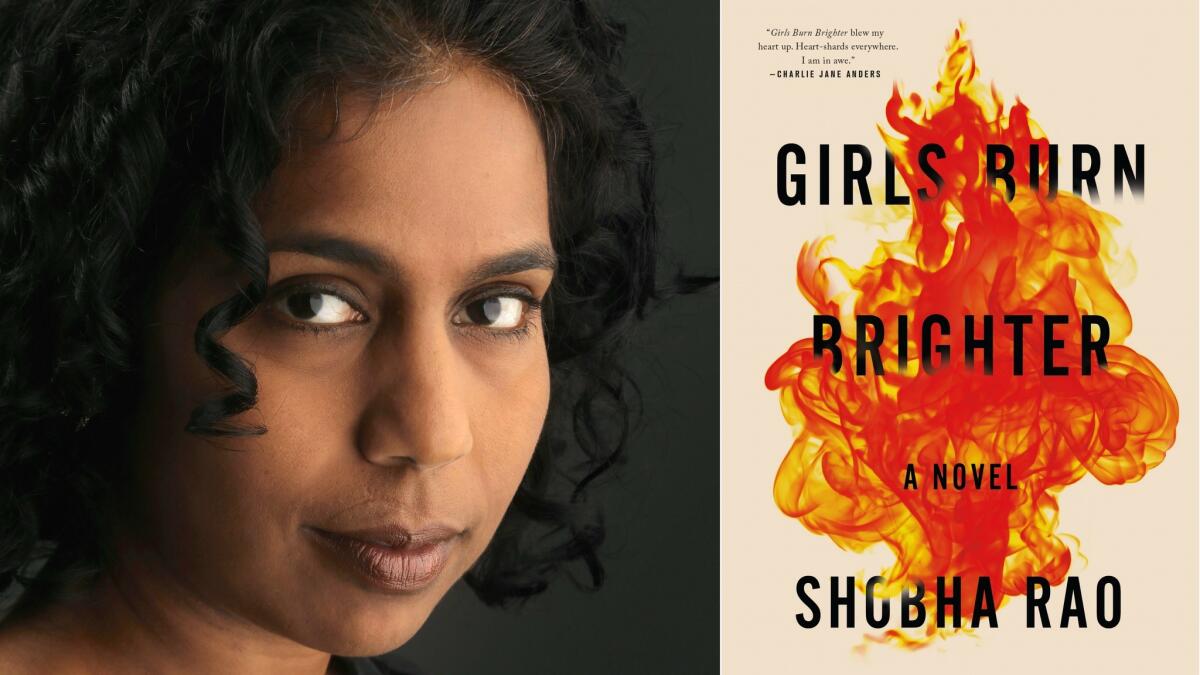Women tend the flames of their ambition in Shobha Rao’s ‘Girls Burn Brighter’

- Share via
Many important novels of the past decade have featured characters who experience extreme hardship: Think of the mother in Emma Donoghue’s “Room,” the astronaut in “The Martian” by Andy Weir’s or Jude in Hanya Yanagihara’s “A Little Life.” That hardship can take many forms, and while most of them are depicted in “Girls Burn Brighter,” debut novelist Shobha Rao has a gift for the physicality of economic deprivation. Her protagonists, Poornima and Savitha, are brought up in stringent circumstances, daughters of poor weavers from the Karnataka, India, village of Indravalli.
The girls meet when Poornima’s father, skilled but addicted to alcohol and sloth, chooses to have Savitha work at his family loom. To keep her working harder and longer, he allows Poornima to cook lunch for them all. Sometimes all the girls have to share besides rice is a spoonful of a curry that is devoured by the father. It’s also here that Savitha reveals her idiosyncratic taste for yogurt rice with a banana mashed in (significant later), a predilection Poornima doesn’t understand well but tries out because of the love these two share.
That love is not precisely platonic or romantic. It doesn’t really matter, because where these girls come from, any attachment between females is risky. Rao wisely takes her time in these early chapters delineating how sere and tough Indravalli life is. Because it’s not just about the poverty. It’s about being born female in a section of Indian society, poor and industrial, that gives everything to men. Curry, technology, whiskey, firewood, housing, education, sexual power, sexual satisfaction, personal fulfillment — name a thing, a category, a concept even, and it is given to the fathers, the sons, the bridegrooms, the husbands, on and on again in a vicious cycle. Women are allowed the “gifts” of household toil and brief shining wedding celebrations if lucky enough to come from a family that can afford a dowry. Women are usually in competition with one another for a place higher in the household pecking order.
Taking time on these relentless humiliations allows the author to amp up the action once Savitha has disappeared and Poornima has been married off, quite badly. The chain of desperation for young women afforded so few advantages leads, when they want to change their lots, to unthinkable abuse. Here, Rao even more wisely pulls back. We’ve seen the bruises and stained sheets before; more interesting is the “brightness” that Savitha recognizes and recalls in her darkest moments. “That lamp glowing from within. How had it survived. . . it was greater than her body. It was greater than all else.” The inner lamp Savitha sees is nothing less than the ambition both she and Poornima have to survive.
After a horrifying family incident, Poornima runs away from her husband’s house with little more than a handful of gold jewelry and a few hundred rupees. While her path overlaps with Savitha’s in the saddest of ways, that overlap also allows her to keep making progress towards reuniting with the one true person in her life. As the sections of the book shift from one perspective to the other, it becomes clear that Rao has created a two-woman quest narrative. Even more fascinating? Their quests are different. While Poornima always knows she’s looking for Savitha, Savitha seeks the more elusive idea of freedom.
Both women are mistreated by men who participate in a global chain of enslavement, prostitution and human trafficking. In many narratives that involve these issues, rescuers come to the fore and women and girls remain inchoate; not so for Rao. Nor does she make Poornima and Savitha into paragons of “feminine” virtue. These are humans with quirks and strengths and flaws: from determined industriousness to resigned submission or a taste for bananas and insecurity about skin tone. That doesn’t mean they are given any special treatment, either. Each must find her own ways to keep her will burning, and ways which may remind readers less of brave Victorian heroines than of concentration camp survivors.
As the characters’ trajectory continues, so does another, from life at subsistence level to life at warp speed. Poornima follows Savitha from Indravalli to the city of Vijayawada on to, ultimately, America (the South Asian characters call Seattle “Sattle”). Whether it’s Poornima’s first trip to see a movie or Savitha’s first view of an American bathtub, the in-from-the-boondocks moments are played quietly and unironically, a tough trick to pull off in a book that also shows scarcity so truthfully. A few chapters towards the end may jump out for the change in tone, as Savitha confronts the cruel truth about women’s fates everywhere, but these chapters also burn brightly. If they are not of a piece with the rest of the novel, that may be due to a common debut novel problem, where the sections written first, with electric intensity, are not fully integrated.
“Girls Burn Brighter” contains many scenes that will make readers seethe at the injustice against women in this world, but what they may remember long after reading is the book’s sustained and elegant prose. Not elegant like, say, a perfectly carved pediment but like human longing pared to its essentials. Shobha Rao writes cleanly and eloquently about women who, without their brightness, might have been left to die in their beds. She writes them into life, into existence, into the light of day.
Patrick is a writer and critic whose work appears in the Washington Post and on NPR Books.
Shobha Rao
Flatiron Books: 304 pp., $25.99
More to Read
Sign up for our Book Club newsletter
Get the latest news, events and more from the Los Angeles Times Book Club, and help us get L.A. reading and talking.
You may occasionally receive promotional content from the Los Angeles Times.






